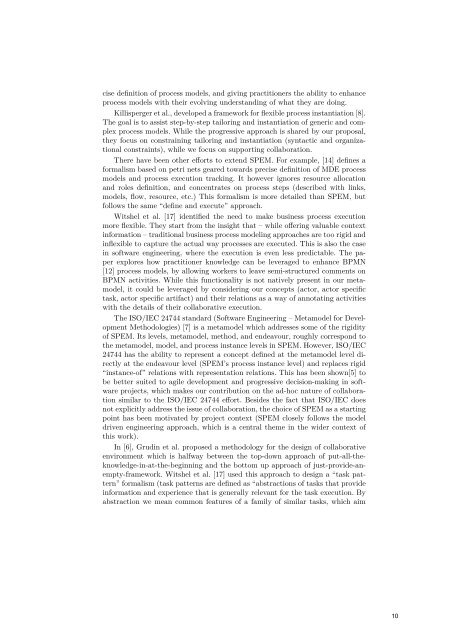A Framework for Integrating ESL Tools - IRIT
A Framework for Integrating ESL Tools - IRIT
A Framework for Integrating ESL Tools - IRIT
You also want an ePaper? Increase the reach of your titles
YUMPU automatically turns print PDFs into web optimized ePapers that Google loves.
cise definition of process models, and giving practitioners the ability to enhance<br />
process models with their evolving understanding of what they are doing.<br />
Killisperger et al., developed a framework <strong>for</strong> flexible process instantiation [8].<br />
The goal is to assist step-by-step tailoring and instantiation of generic and complex<br />
process models. While the progressive approach is shared by our proposal,<br />
they focus on constraining tailoring and instantiation (syntactic and organizational<br />
constraints), while we focus on supporting collaboration.<br />
There have been other ef<strong>for</strong>ts to extend SPEM. For example, [14] defines a<br />
<strong>for</strong>malism based on petri nets geared towards precise definition of MDE process<br />
models and process execution tracking. It however ignores resource allocation<br />
and roles definition, and concentrates on process steps (described with links,<br />
models, flow, resource, etc.) This <strong>for</strong>malism is more detailed than SPEM, but<br />
follows the same “define and execute” approach.<br />
Witshel et al. [17] identified the need to make business process execution<br />
more flexible. They start from the insight that – while offering valuable context<br />
in<strong>for</strong>mation – traditional business process modeling approaches are too rigid and<br />
inflexible to capture the actual way processes are executed. This is also the case<br />
in software engineering, where the execution is even less predictable. The paper<br />
explores how practitioner knowledge can be leveraged to enhance BPMN<br />
[12] process models, by allowing workers to leave semi-structured comments on<br />
BPMN activities. While this functionality is not natively present in our metamodel,<br />
it could be leveraged by considering our concepts (actor, actor specific<br />
task, actor specific artifact) and their relations as a way of annotating activities<br />
with the details of their collaborative execution.<br />
The ISO/IEC 24744 standard (Software Engineering – Metamodel <strong>for</strong> Development<br />
Methodologies) [7] is a metamodel which addresses some of the rigidity<br />
of SPEM. Its levels, metamodel, method, and endeavour, roughly correspond to<br />
the metamodel, model, and process instance levels in SPEM. However, ISO/IEC<br />
24744 has the ability to represent a concept defined at the metamodel level directly<br />
at the endeavour level (SPEM’s process instance level) and replaces rigid<br />
“instance-of” relations with representation relations. This has been shown[5] to<br />
be better suited to agile development and progressive decision-making in software<br />
projects, which makes our contribution on the ad-hoc nature of collaboration<br />
similar to the ISO/IEC 24744 ef<strong>for</strong>t. Besides the fact that ISO/IEC does<br />
not explicitly address the issue of collaboration, the choice of SPEM as a starting<br />
point has been motivated by project context (SPEM closely follows the model<br />
driven engineering approach, which is a central theme in the wider context of<br />
this work).<br />
In [6], Grudin et al. proposed a methodology <strong>for</strong> the design of collaborative<br />
environment which is halfway between the top-down approach of put-all-theknowledge-in-at-the-beginning<br />
and the bottom up approach of just-provide-anempty-framework.<br />
Witshel et al. [17] used this approach to design a “task pattern”<br />
<strong>for</strong>malism (task patterns are defined as “abstractions of tasks that provide<br />
in<strong>for</strong>mation and experience that is generally relevant <strong>for</strong> the task execution. By<br />
abstraction we mean common features of a family of similar tasks, which aim<br />
10

















